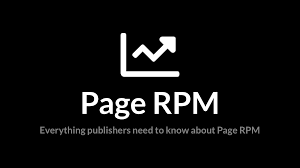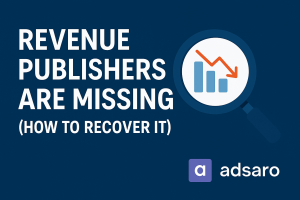Page RPM (Revenue per Mille) is one of the most critical metrics for any digital publisher aiming to monetize content effectively. It calculates how much revenue you earn for every 1,000 page views and gives a clear picture of your monetization efficiency. However, many publishers focus solely on traffic without realizing that optimizing for RPM can significantly boost ad revenue—sometimes more than increasing raw traffic.
In this comprehensive guide, we’ll explore the most effective ways to increase page RPM using proven, data-driven monetization strategies for publishers. From technical optimizations to content strategies, this post covers everything you need to know to improve your bottom line.
What is Page RPM?
Page RPM stands for Revenue per Mille (“mille” means thousand in Latin) and is a metric that indicates how much revenue a publisher earns per 1,000 page views. It is a crucial measurement used by publishers to understand the earning potential of their website content and ad placements.
Formula to calculate RPM:
Page RPM = (Estimated Earnings / Number of Page Views) x 1,000
A higher RPM means you’re monetizing your traffic more effectively. It’s not just about how many visitors come to your site—but how much revenue each visit generates.
1. Understand What Drives Page RPM
Before you can increase page RPM, it’s crucial to understand what it’s made of. The formula is simple:
Page RPM = (Estimated Earnings / Number of Page Views) x 1,000
Key factors that influence this metric include:
- Ad viewability
- Click-through rates (CTR)
- Traffic geography and quality
- Ad formats and placement
- User engagement levels
By improving even one of these elements, you can positively affect your RPM and, in turn, boost ad revenue.
2. Optimize Ad Layout and Placement
Your ad layout plays a significant role in determining how well your ads perform. Thoughtfully positioned ads that integrate naturally with your content tend to perform better.
Here’s how to optimize ad layout:
- Place high-performing ad units above the fold for maximum visibility.
- Use in-content ads that flow with the article.
- Implement sticky ads (e.g., anchor ads on mobile) for constant exposure.
- Avoid overwhelming your visitors with too many ads—balance is key.
Using A/B testing and heatmaps can help identify the most lucrative ad placements on your site.
3. Improve Mobile User Experience
With over half of global traffic coming from mobile devices, optimizing for mobile is a non-negotiable step to improve RPM.
Mobile optimization strategies:
- Use responsive ad units to ensure ads fit all screen sizes.
- Optimize site speed for mobile devices.
- Minimize intrusive ads that lead to accidental clicks.
- Improve mobile navigation and readability.
A smooth mobile experience leads to longer sessions, better engagement, and more ad impressions—directly contributing to increased RPM.
4. Experiment with High-Performing Ad Types
Not all ad formats are created equal. Some ad types consistently yield higher RPMs and better user engagement.
Top-performing ad formats:
- Native ads: Blend in with content and achieve higher CTRs.
- Video ads: Offer higher CPMs, especially when placed strategically.
- Rich media ads: Interactive formats often lead to greater engagement.
Publishers should test different combinations and placements to find what works best with their content and audience.
5. Focus on High-Quality, Intent-Driven Traffic
The source and quality of your traffic play a major role in how much advertisers are willing to pay. To increase page RPM, prioritize attracting the right kind of visitors.
How to attract high-value traffic:
- Create content targeting high-intent keywords.
- Use SEO best practices to rank for topics with high advertiser demand.
- Promote content through social media and email marketing that aligns with user intent.
- Avoid low-quality traffic sources that inflate page views but don’t engage.
High-intent users are more likely to click on relevant ads, thereby boosting RPM.
6. Implement Header Bidding
Header bidding is a technique that allows multiple ad exchanges to bid on the same inventory in real time. This increases competition and often results in higher CPMs, directly improving RPM.
Benefits of header bidding:
- Increases demand for your ad inventory.
- Offers better transparency into bid values.
- Enhances fill rates and overall yield.
While it may require some technical setup, partnering with a good ad tech provider can simplify the process.
7. Enable Lazy Loading for Ads
Lazy loading delays the loading of ads until they’re about to come into the user’s view. This technique not only improves site speed but also increases ad viewability, a key factor for better RPM.
Advantages of lazy loading:
- Faster initial page load times.
- Better user experience.
- Higher viewability scores, which can lead to premium ads being served.
This small tweak can lead to significant improvements in RPM over time.
8. Analyze and Optimize Regularly
Monitoring and analyzing your RPM data is essential for ongoing growth. Publishers should look beyond the averages and study RPM at a granular level:
- Compare RPM across different content categories.
- Identify which pages or traffic sources have the highest RPM.
- Track RPM trends by device and geography.
Using platforms like Google Ad Manager and integrating with Google Analytics can give you actionable insights to further boost ad revenue.
Conclusion
Improving page RPM isn’t a one-time task—it’s a continuous process of optimization, testing, and understanding your audience. Rather than simply increasing traffic, publishers should focus on increasing the value of every single page view.
By implementing the strategies outlined above—such as optimizing ad layout, improving mobile UX, experimenting with high-performing formats, and leveraging header bidding—you can significantly boost ad revenue and build a sustainable, high-performing publishing business.
Stay focused, analyze data regularly, and never stop testing. The path to a higher RPM starts with smarter monetization, not more ads.








Leave a Reply